Urasawa (Beverly Hills, CA) [3]
Urasawa
218 N Rodeo Dr, Beverly Hills, CA 90210
310.247.8939
www.yelp.com/biz/urasawa-beverly-hills (Yelp, restaurant has no web site)
Sat 10/04/2008, 08:00p-12:30a
Three times a charm? Since this is my third Urasawa report, I'll skip the typical introductory and decor sections (see my previous posts here and here for that) and get straight to the vittles. As an interesting aside, we found out that Urasawa-san's sister, Yoshie, was working here now. She started a while ago, after business picked up due to the restaurant's garnering of a two-star Michelin rating. Apparently, the secret's out!
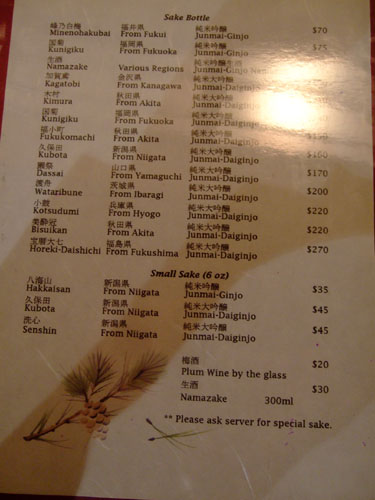
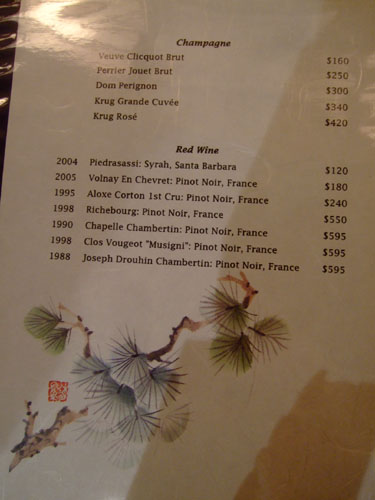
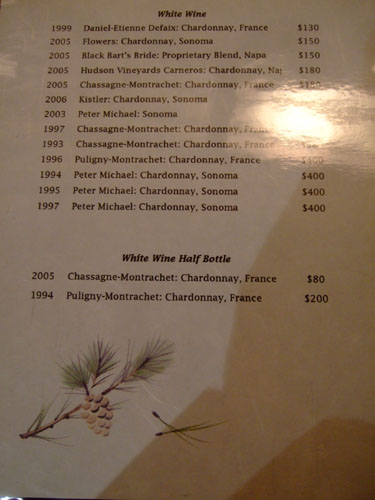
A nice selection of premium sakes is available, and I always like to start with sake for the kaiseki portion of the meal, while I reserve Champagne for the sushi. Wine is also available, though I wonder about the reds. Wouldn't they overpower the delicate flavors of Urasawa's cuisine (especially the sushi)? The list is French- and California-focused, with mark ups being on the higher end of the range. Click for larger versions.
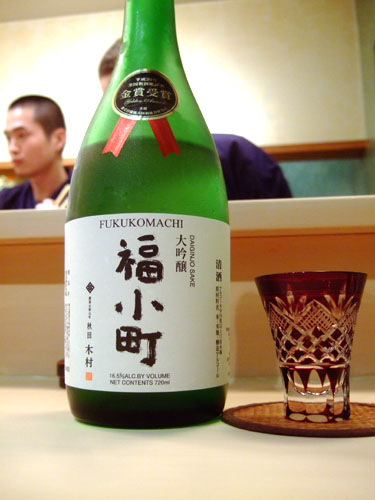
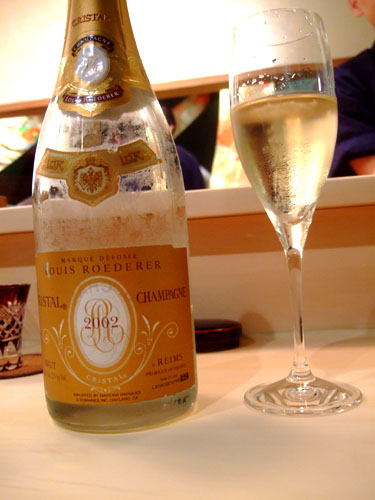
For sake, we went with a new one, the Fukukomachi [$150], a daiginjo (I believe the sake list incorrectly lists it as a junmai-daiginjo) from the Kimura Brewery in Akita. The details are: +5.0 specific gravity, 16.5% alcohol, 40% polish ratio, Yamadanishiki rice. I found it rather tasty: smoky, slightly viscous, with a tinge of fruity sweetness and vanilla. For the sushi, I brought a bottle of 2002 Louis Roederer Cristal Brut from my personal cellar (corkage is up to $50!). I liked it better than the last time I had it, at Capo. It seemed more refined, smoother, softer, yet still abound with hints of stone fruit, citrus, and toast; I think this will be even better with more age. We offered Urasawa-san some, and he seemed to enjoy it as well, finishing his entire glass!
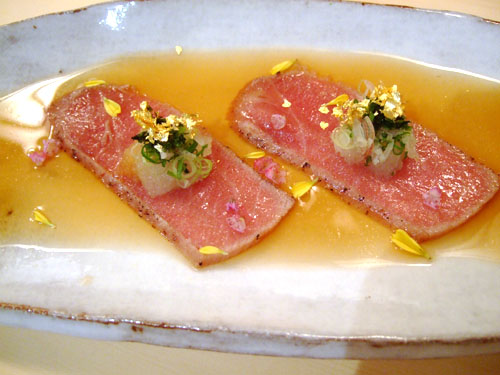
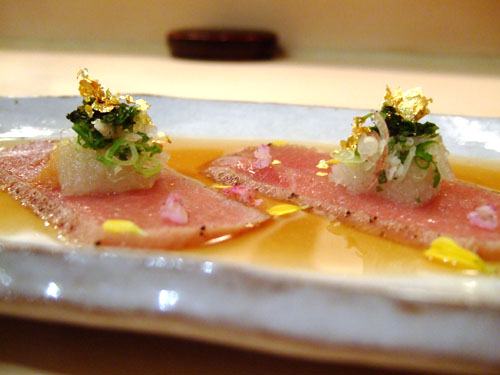
1. Toro Tataki - Seared toro, orange ponzu, daikon, scallion, shiso, gold foil, chrysanthemum flower, shiso flower. The topping of scallion and daikon went wonderfully with the two beautifully seared pieces of toro, adding complexity and textural contrast, while the ponzu added a reverberating sweetness. A great way to kick off the meal, though I think the ponzu could've had more savory components (perhaps soy?) to offset its overt sweetness.
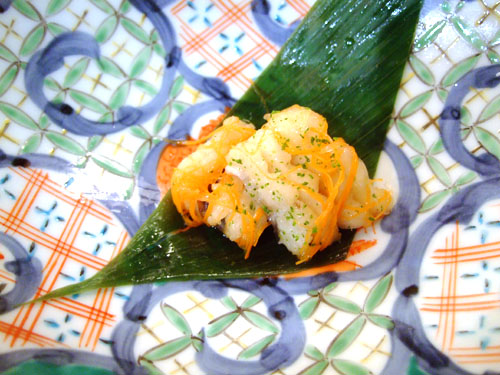
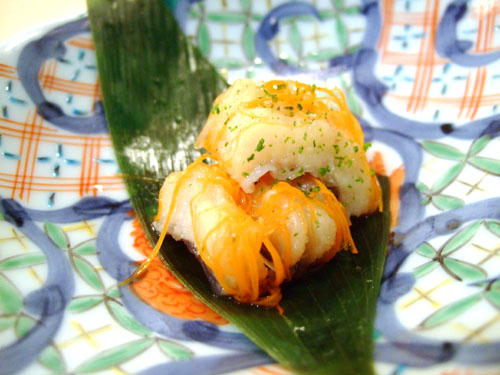
2. Hamo Nambanzuke - I think this was the first time I've had hamo. Hamo is also known as daggertooth pike conger eel, pike eel, or simply king eel (as Urasawa-san called it). Here, it was presented nambanzuke style, basically marinated in sweet vinegar and lightly fried, and covered by strands of carrot and grated sudachi. The eel had an initial sweetness and tartness (probably due to the marinade), which then led way to a ham-like smokiness. One of my dining companions even likened the taste to bacon!
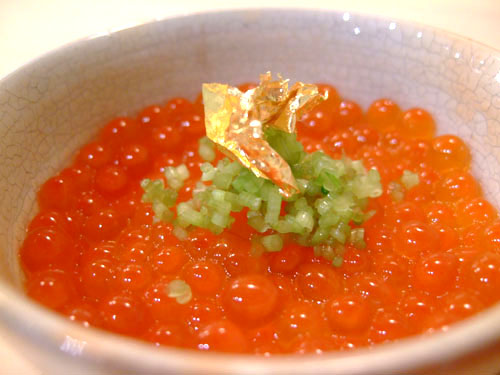
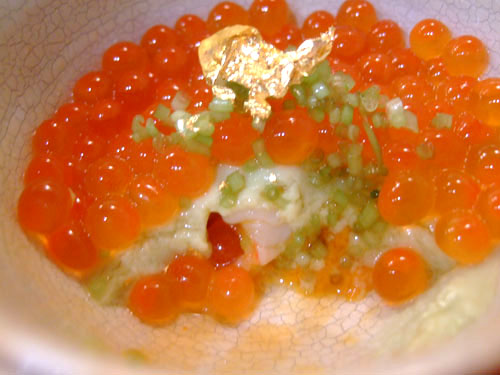
3. Edamame Tofu - Edamame tofu is a type of kinugoshi (silken) tofu made from edamame, or fresh green soybeans (as opposed to soy milk), which give the tofu its unique pale green tint. It had a very soft, custard-like texture, with a flavor highlighted by nutty notes of soybean. In this dish, the tofu was accompanied by ikura, ebi, uni, mitsuba vegetable (Japanese wild parsley, or honeywort), and gold foil. The salmon roe added a great salty tang to the relatively mild tofu, while the mitsuba contributed a slight bitterness and a fantastic crunchiness to the dish.
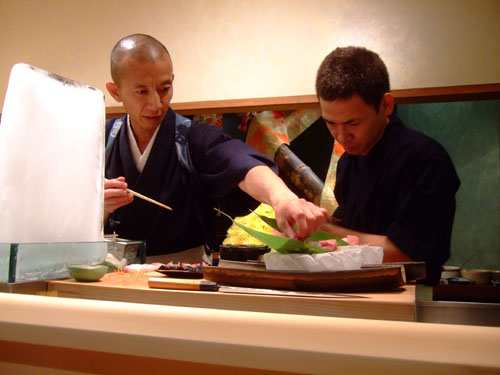
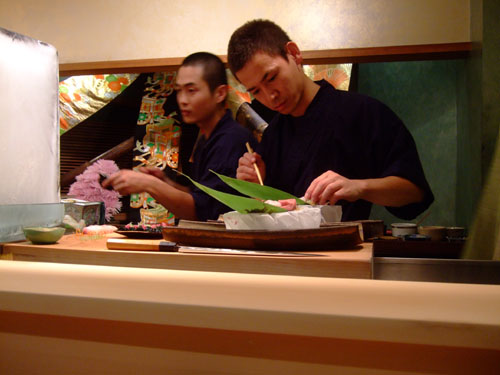
In this most recent visit, it seemed like Urasawa-san's new assistant (and his brother-in-law), Ken I believe is his name, has been taking on more responsibility in terms of the food. Above, we see him preparing the sashimi course. As I mentioned in my last report, Urasawa-san's last assistant, Sung, has moved on to become a chef at French Laundry. Apparently, Sung wanted to learn more about French culinary technique, and, from what I understand, his desire became a reality when French Laundry's Chef de Cuisine Corey Lee came to visit Urasawa. Thomas Keller was a friend of Masayoshi "Masa" Takayama, Urasawa-san's teacher (legend has it Keller convinced Masa to move to New York), so it just seems appropriate that Urasawa-san and Keller's protégé, Lee, would cross paths.
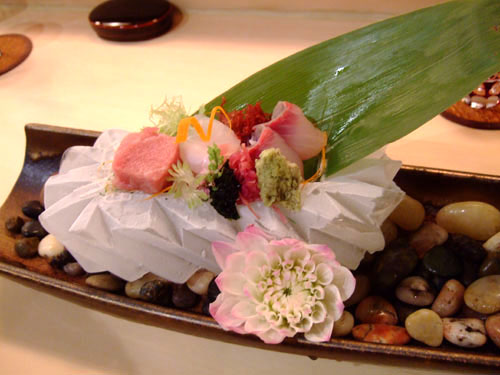
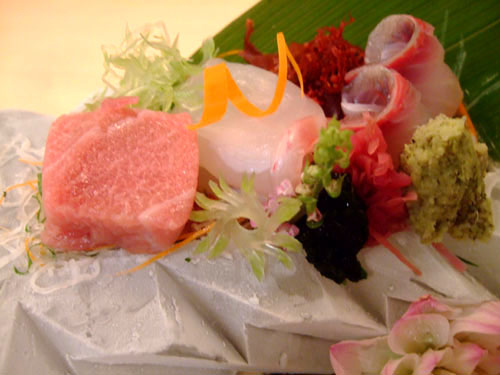
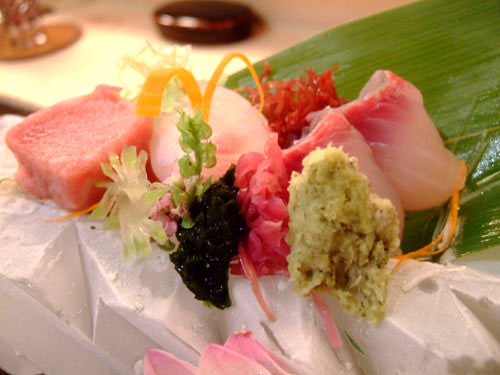
4. Sashimi - Set in a hand-carved ice block, the three types of fish were toro from Boston, tai from Kyushu, and kampachi from Toyama. Accoutrements included fresh wasabi from Shizuoka (which produces over half of the wasabi in Japan), red cabbage, nori, and daikon. The toro was quite fatty, though a bit tendinous, while the snapper and kampachi were very mild and clean tasting, with no hint of fishiness. We were told to put seaweed in the provided soy sauce, which really complemented the fish, adding layers of complexity and contrast. A funny thing happened when I tried to sample the wasabi alone. Ken nearly jumped over the counter to stop me! I had to reassure him that I just wanted to see what the wasabi was like on its own.
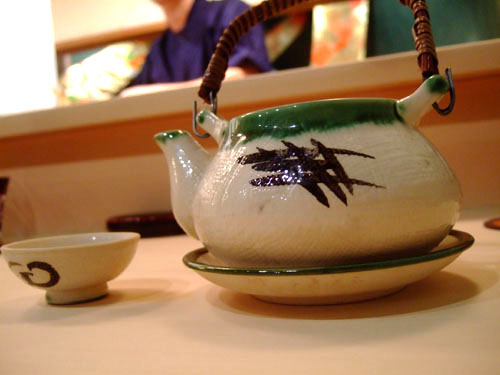
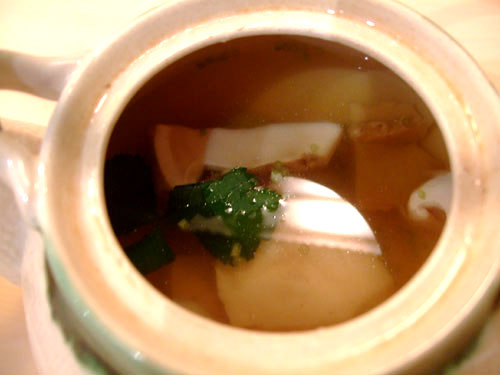
5. Dobin Mushi - The dobin mushi was a soup consisting of matsutake mushroom, awabi, ebi, tai, gingko, mitsuba, and sudachi. The stock is dashi-based, which gives the soup a sweet-smoky taste, while the sudachi adds a notable tangy zest. The best part however, were the matsutakes and their woody, earthy flavor; the timing of our visit was good, as matsutake season starts in September. The soup was served in a clay tea pot, along with a small saucer. After eating the various ingredients, you pour the soup in the saucer to drink (tricky apparently--my dining companions had trouble with spillage), and the requisite small sips make you savor the soup even more. Fantastic!
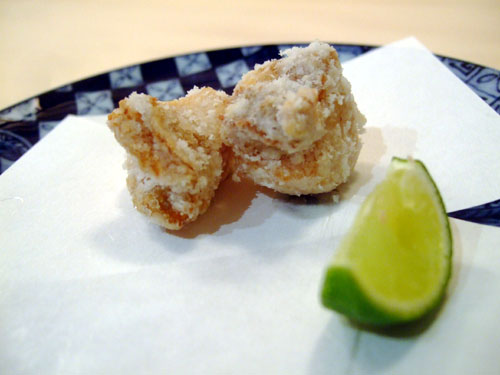
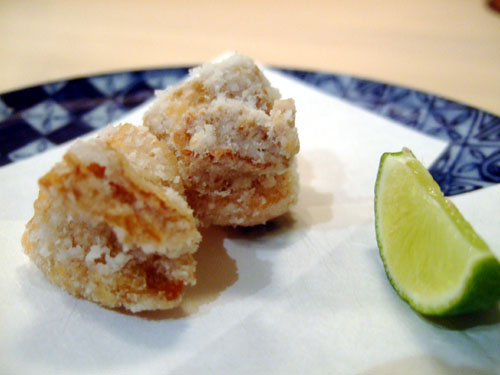
6. Awabi "Karaage" - Fried Japanese abalone, served with a hint of sudachi juice. This was one of the best preparations of abalone I'd ever had, next to the awabi nigiri I had at Go's Mart. The pieces were tender, the result of six hours of boiling with kombu, but still had a delightful crunch. Taste-wise, the abalone was very subtle, very refined, great by itself, but enhanced even further by the zest of sudachi. I could just eat a whole bucket of this, like it were KFC popcorn chicken!
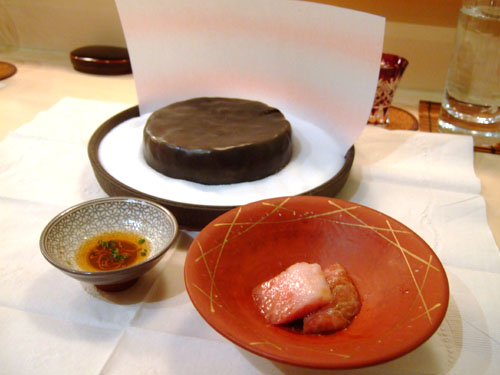
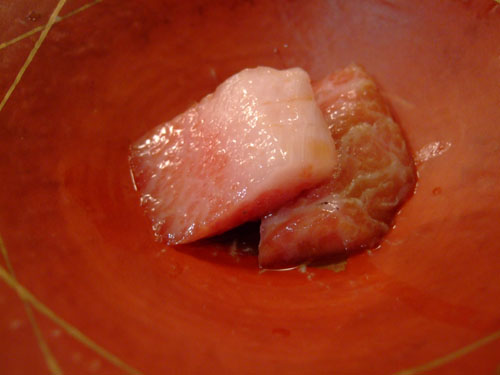
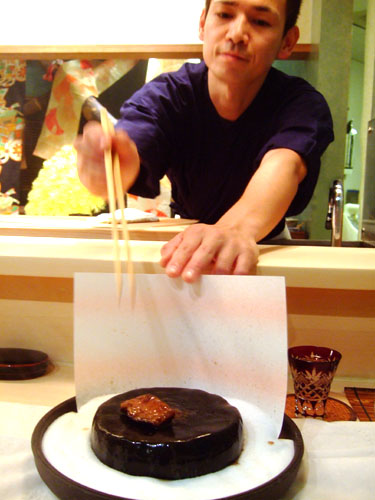
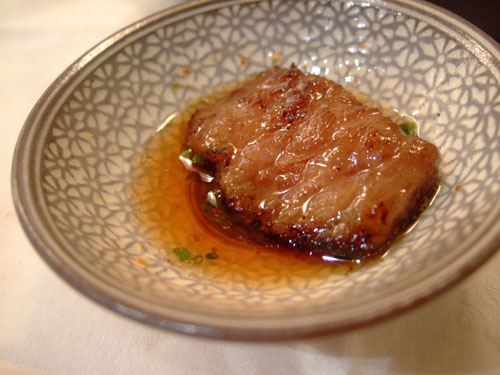
7. Seared Toro - I believe this was actually kama toro, or toro from the collar of the tuna. Rarer and pricier than mere toro, it's even more melt-in-your-mouth, and even more flavorful! Upon touching the hot stone, the fish produced a plume of rich, oily smoke that enveloped the surrounding area (that's why napkins were laid down--to protect the counter). Mouths watering, we waited intently as our servers lifted the toro off the hot stone and plopped it down into a bath of ponzu. At this point, the toro was looking not like fish, but beef. Eating the result was like an explosion of flavor and fat in my mouth, and elicited a moan of satisfaction from me.
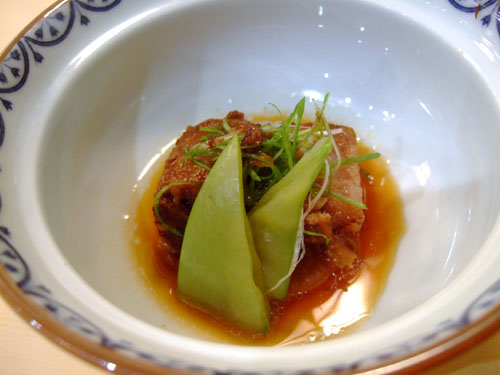
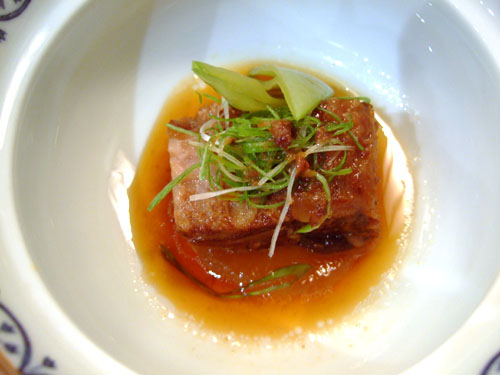
8. Saga Beef - The meat was boiled with sake and soy for two days, resulting in an incredibly soft, yet rich consistency, and a taste that was both sweet and savory. Flavor-wise, it reminded me a bit of Chinese-style braised beef, but the texture was totally different. The fat was very fine, very integrated, but not overwhelming; it was easy to chew, but provided just enough resistance to make it interesting. The various vegetables, meanwhile, added some contrast to the meat; otherwise, it would've been too monolithic. I liked this even better than the Saga beef I had on my first visit to Urasawa.
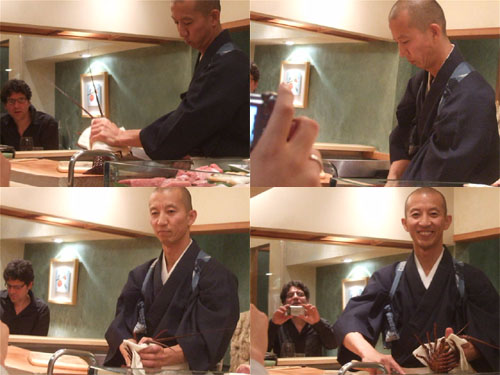
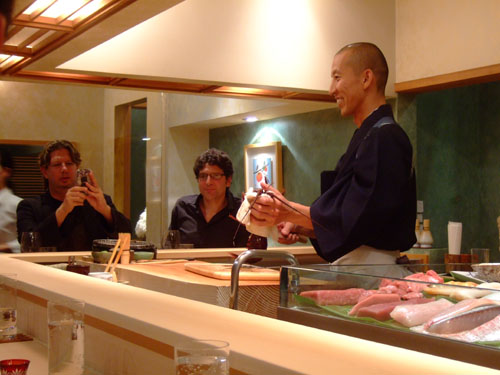
Click the photo on the left for a video of Urasawa-san preparing a spiny lobster for our shabu-shabu course. He made sure to ham it up for the camera!
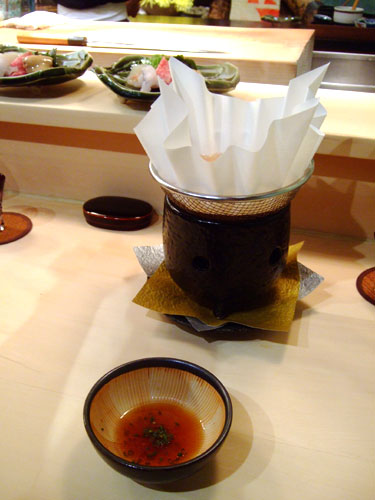
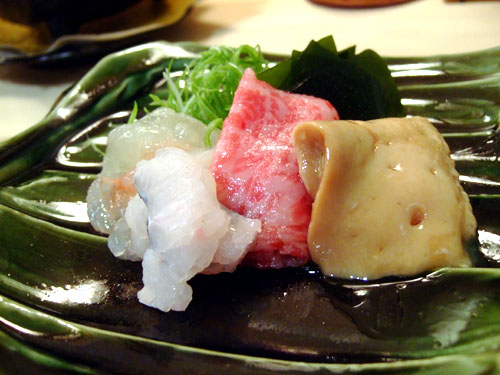
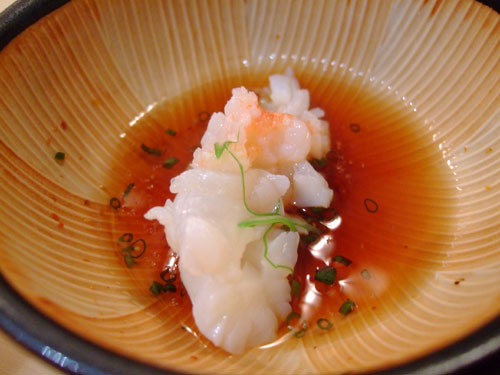
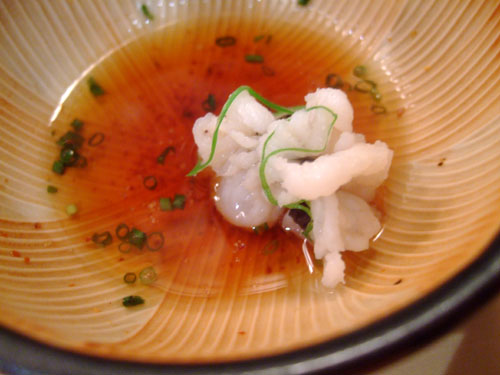
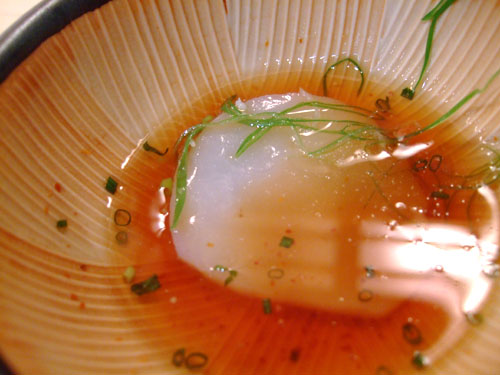
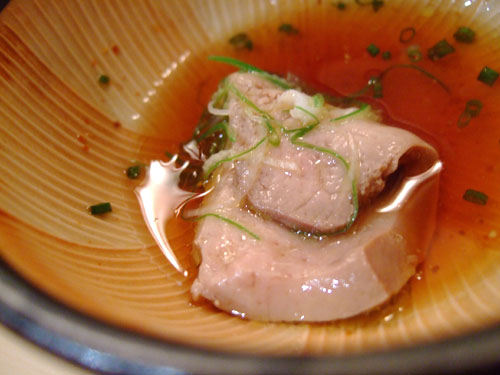
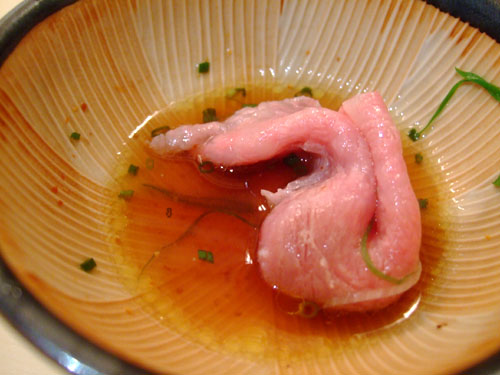
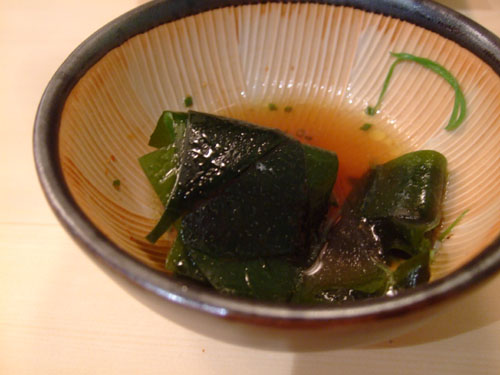
9. Shabu-Shabu - The number of ingredients for the shabu-shabu just keep on increasing. The first time, it was three, then four the next time, now five! We had ise ebi (spiny lobster), hotate (scallop), hamo (king eel), Saga beef, and foie gras. The first item our servers plopped in was the foie, followed by the lobster. The lobster came out quickly and was great, with a superb sweetness and snap. Next was the king eel, which I preferred to the nambanzuke version. The scallop came next, which I found to be a bit nondescript, the weakest of this quintet. Finally, it was time for the foie, which turned out wonderfully, with a subtle, yet powerful taste and a delightful, slightly rubbery texture; it was one of the best cooked preparations I've had (my best ever is still a foie gras terrine at French Laundry though). Following the foie was the beef, which was arguably my favorite of the bunch. Finally, we were instructed to take out and eat the kombu kelp (a change from previous visits, where the kombu stayed in).
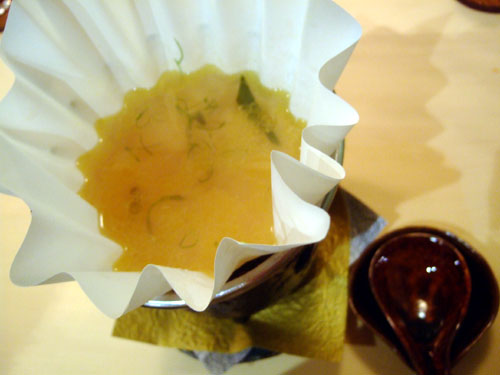
10. Kombu Broth - As usual, the remaining kombu stock formed a hearty soup to enjoy before the sushi courses. This time, the soup had a very recognizable essence of foie gras, which had absolutely permeated the liquid! Upon sipping, you're hit initially by a light, kombu-tinged flavor, which quickly gives way to the richness of the foie.
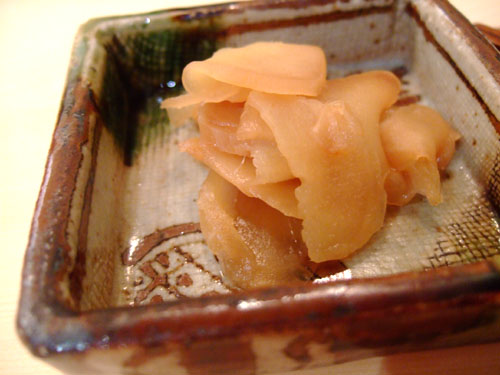
With the appearance of gari (ginger), we knew that the gauntlet of sushi was about to begin.
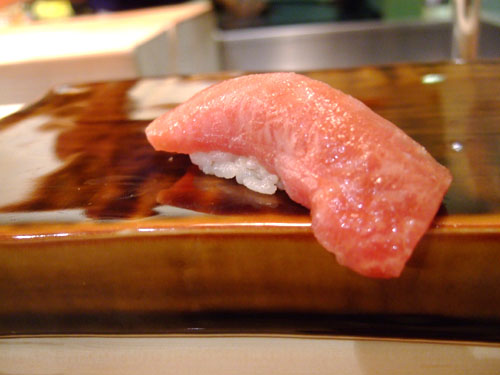
11. Toro - Very nice, with a clean, yet rich taste, though noticeably less oily and less fatty than kama toro. Although Urasawa's toro is arugably the best I've had in the States, it wasn't quite as strong as the toro I had at Kyubey in Tokyo, which remains my best to date.
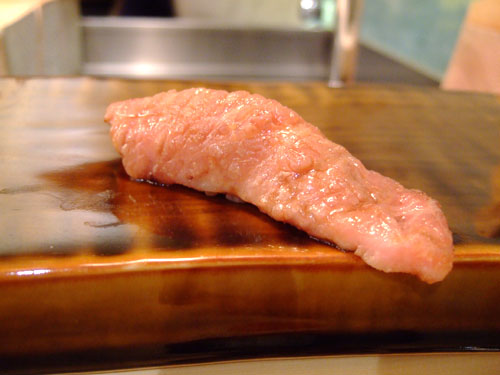
12. Seared Toro - The regular toro was just about perfect, but cooking the fish slightly seemed to make it even better. It softened the meat, accentuated the oiliness of the fish, and added a touch of smokiness that resulted in further complexity and contrast.
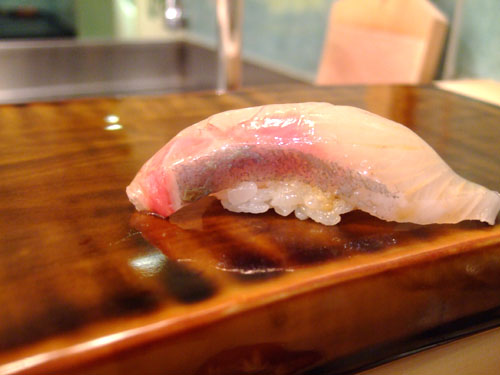
13. Kampachi - I preferred this preparation of kampachi to the sashimi version. It had a more toothsome taste as well as a more satisfying, crunchier texture.
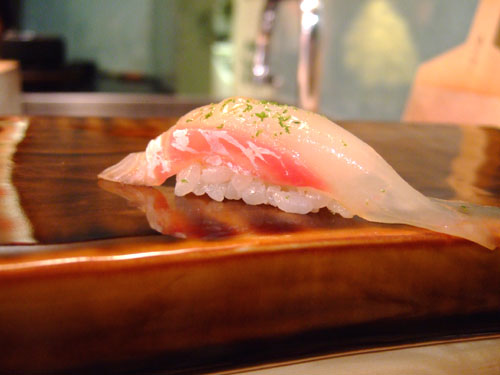
14. Tai - A beautiful piece of fish, this snapper, as with the kampachi, outshone the sashimi we had earlier in the night. The sudachi zest added a fantastic tanginess to the fish, and the tai's slightly chewy texture was an added bonus.
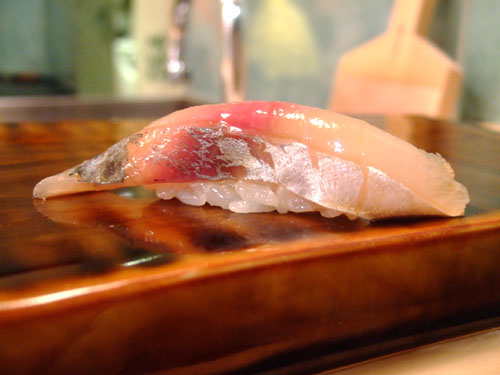
15. Seki Aji - I was told that this was not mere aji (Spanish mackerel), but Seki aji from Kyushu. Considered pretty much the best aji available, Seki aji is caught in the Bungo Straight, which separates Kyushu from Shikoku; Seki saba is also available. The fish was very mild, lacking any of the offensive fishiness found in some lesser quality mackerels. I believe the only other place I've had Seki aji was Go's Mart. An interesting note: when we were served this, I asked about the distinction between aji and sawara. If I understood correctly, it seems like "sawara" refers to Spanish mackerel in the New York region, while outside the area, the term "aji" is generally used.
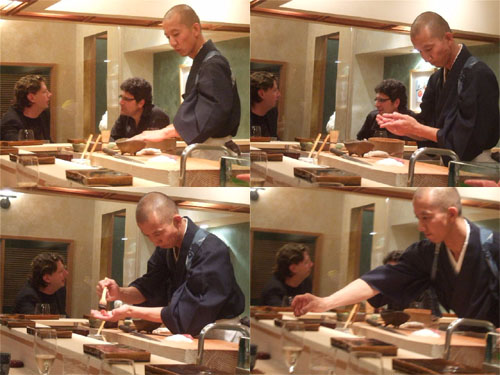
Click the photo above for a video of Urasawa-san preparing a piece of maguro nigiri sushi.
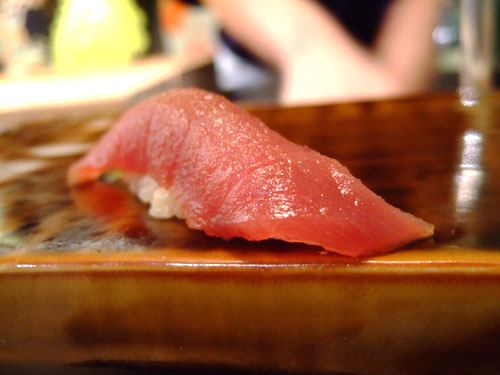
16. Maguro - We were told that this was bluefin tuna. Tuna can often times be quite boring, but the liberal use of wasabi here made the fish more interesting than I expected.
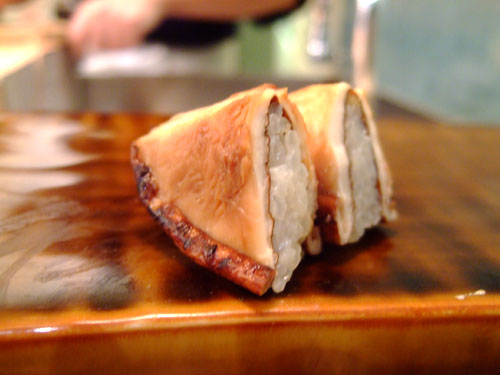
17. Shiitake - Urasawa remains the only place where I've had shiitake sushi. It's one that I look forward to, as its simple preparation really lets the woody, earthy nature of the mushrooms shine through, highlighted by a bit of wasabi.
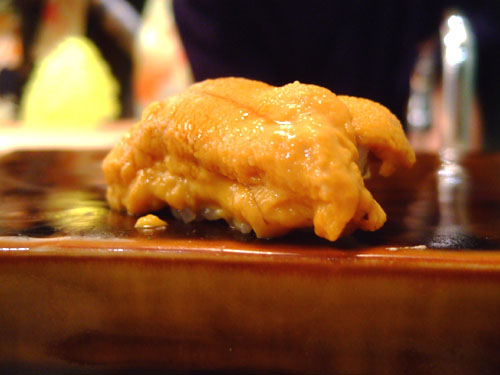
18. Uni - This was some of the best uni I've had! Ridiculously creamy and quite sweet, it had absolutely no bitterness to it. The uni was from Santa Barbara. Unfortunately, one of the other diners at the restaurant, who I assume was drunk, rudely questioned this choice of SB uni, which seemed to upset Urasawa-san. He basically asked: "Why do you use Santa Barbara uni? Have you tried all the other unis? How do you know it's the best?" To which Urasawa-san replied: "Because I'm the chef!"
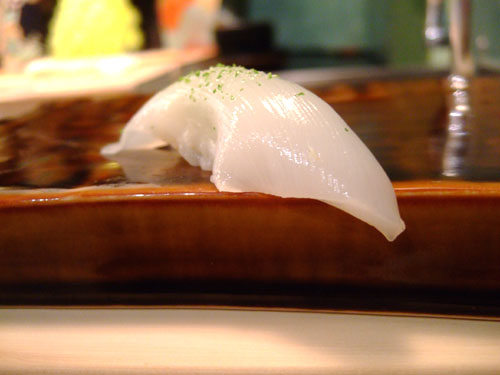
19. Ika - The toppings of sudachi and seaweed salt really added a fitting contrast to the mild flavor of the squid. Texture-wise, the ika was nicely firm, with a rich, almost creamy complexion that coated the mouth.
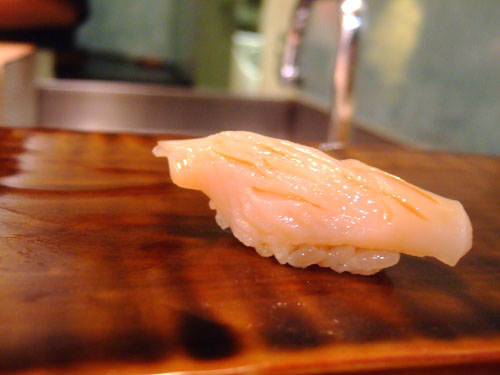
20. Mirugai - Mirugai is also known as geoduck. It had a refreshing crunch to it, as well as a clean, briny flavor and just a hint of sweetness.
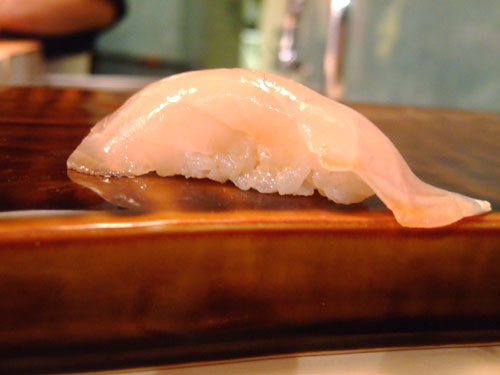
21. Shima Aji - Striped jack or yellowjack, this was one of my favorites last time I was here. This time, it wasn't quite as strong, as it seemed to lack the level of complexity I experienced before. Nevertheless, it was still delectable.
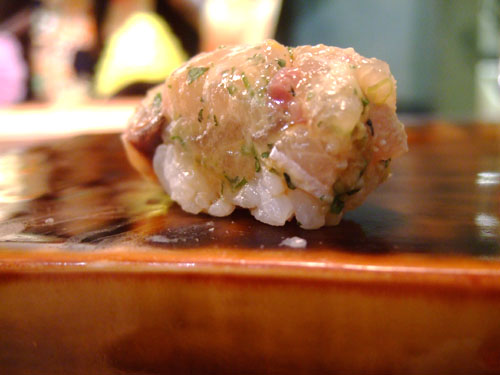
22. Aji No Tataki - This was minced Spanish mackerel, along with shiro miso from Kyoto, scallion, shiso, and ginger. Urasawa is the only place I've seen do something like this. There were so many layers of flavor going on here, with the fish serving as a formidable base for the sweetness of the miso, bitterness of the scallion, and tang of the ginger and shiso.
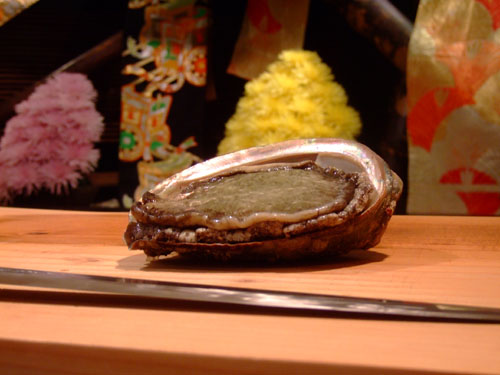
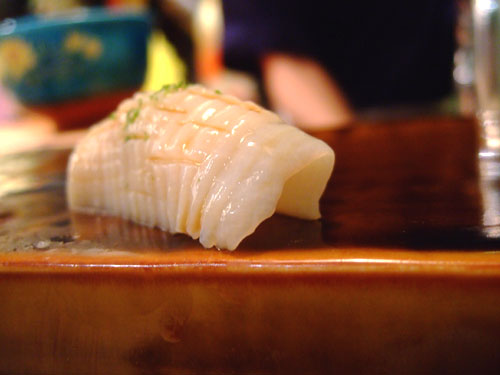
23. Awabi - Here we see a before and after. The abalone had a nice firm crispness, with a good application of sudachi to counteract the brininess of the mollusk. Note the scoring on the surface of the abalone, which served to tenderize it.
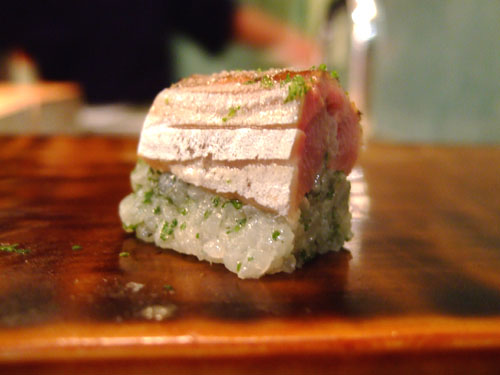
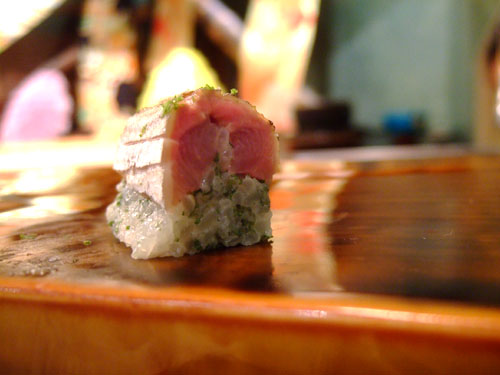
24. Sanma - Mackerel pike or Pacific saury, with salt, sudachi, served on rice mixed with chopped shiso. The preparation of this dish was interesting, as it was made in one long piece of nigiri (I presume since the fish is long and thin), then cut, almost like a roll. It was "grilled" with a hot metal rod pressed against the top of the fish, which actually caused flames to shoot out from the surface! Again, I've never had anything quite like this at any other restaurant. The sanma had a distinctive saltiness and fishiness to it, balanced by a subtle sweetness.
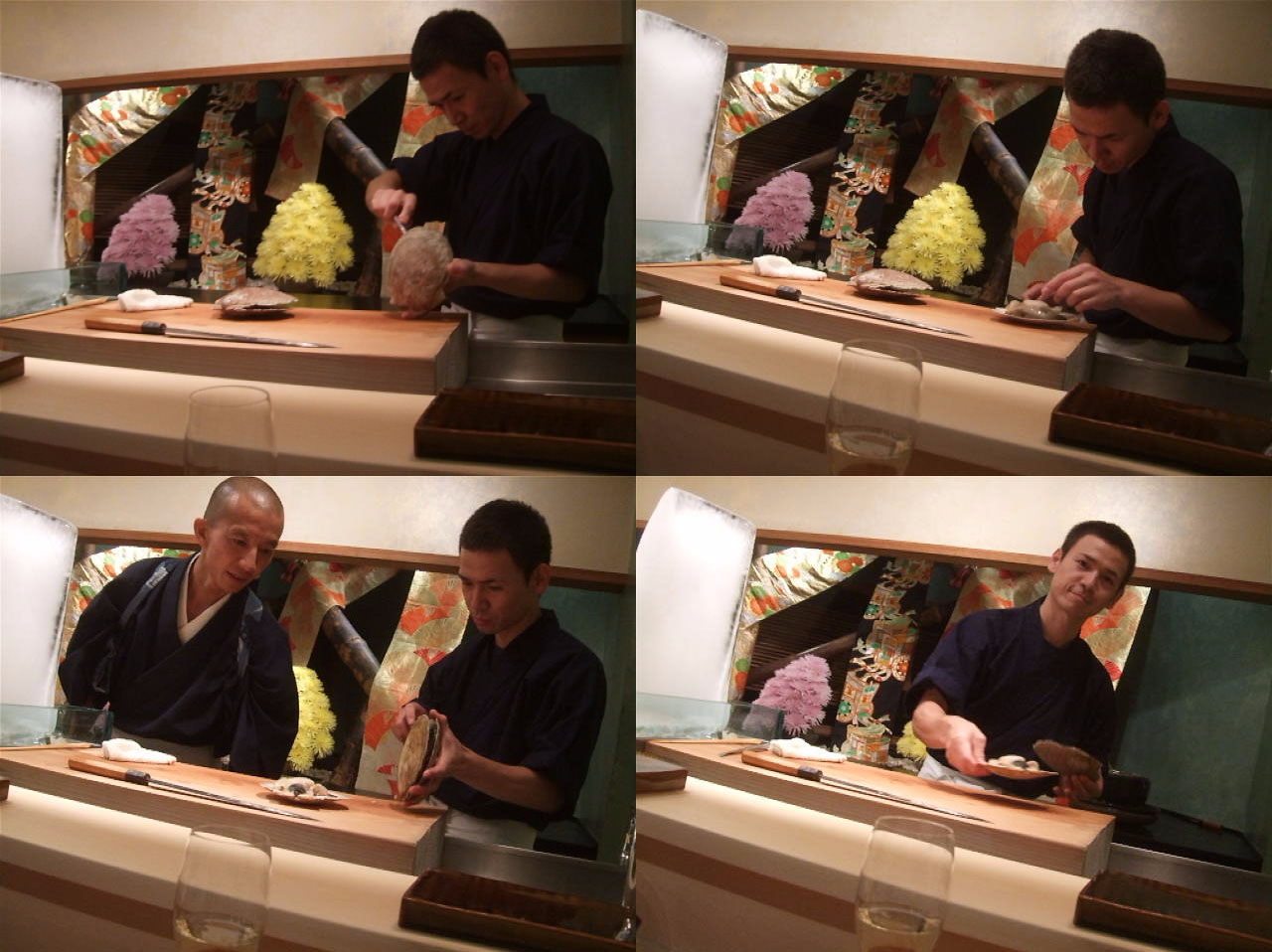
Click on the photo above for a video of Ken preparing scallop. He cut open two scallops, only to find them unresponsive, and thus not fit for serving. They were thrown out, though I think we would've enjoyed eating them anyway!
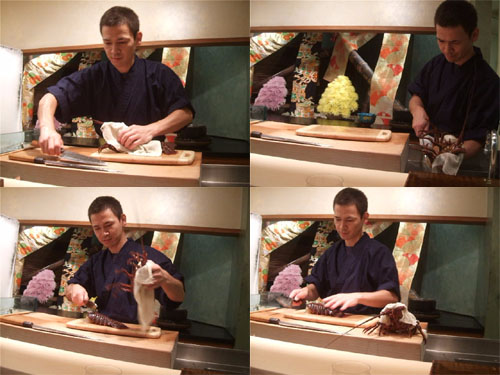
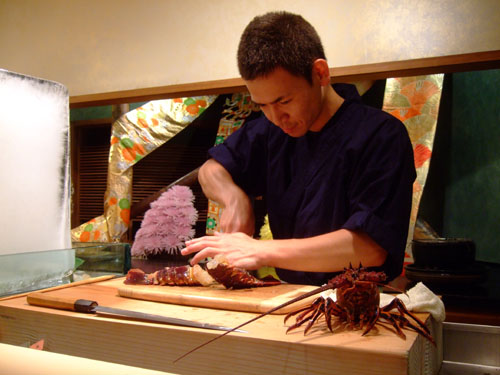
So instead of scallop, we got spiny lobster instead. Click the photo on the left for a video of Ken prepping the live lobster, which continued to move about even after being cut in half!
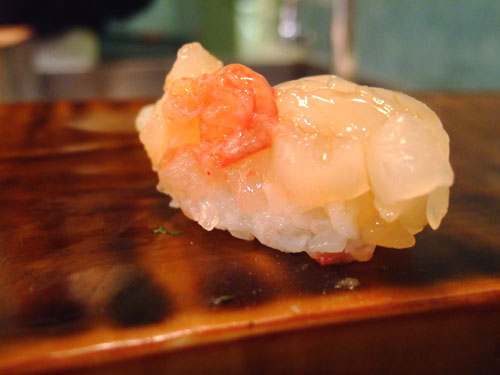
25. Ise Ebi - Spiny lobster, otherwise known as rock lobster; despite the name, it's actually not a "true" lobster. Nevertheless, the flesh tasted very fresh (as it should, given the lobster was alive just minutes prior!), with a satisfying crunch and a nice bit of sweetness. I preferred this sushi preparation to the shabu-shabu above.
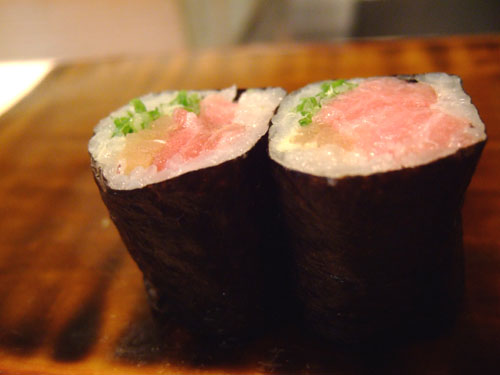
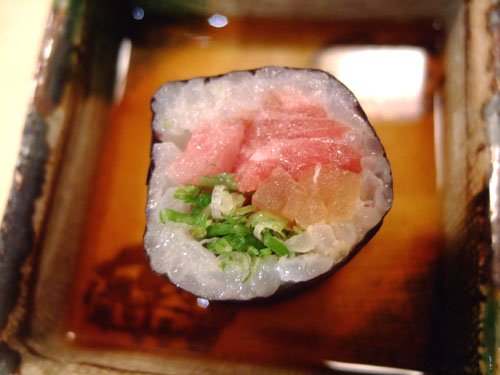
26. Negitoro Maki - Toro with negi (leek) and takuan (pickled daikon, believed to help aid digestion). The daikon came in a wheel-like shape, from which Urasawa-san cut long, thin strips. I really enjoyed the great crunch and sourness of the takuan and how the bitterness of the scallion contrasted with the richness of the tuna. It was good alone but even better when eaten with the provided soy sauce.
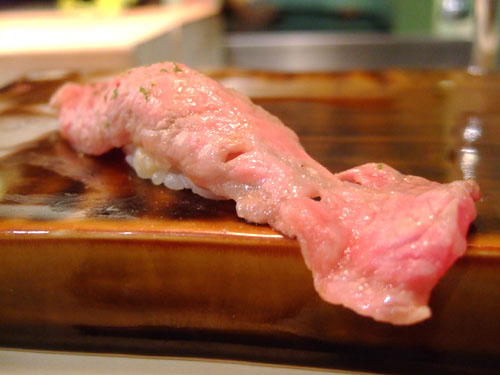
27. Gyusashi - This was our third helping of Saga beef! It had a mildly smoky flavor, paired with an extremely soft, yet chewy texture. I liked it better than shabu-shabu version. Delish!
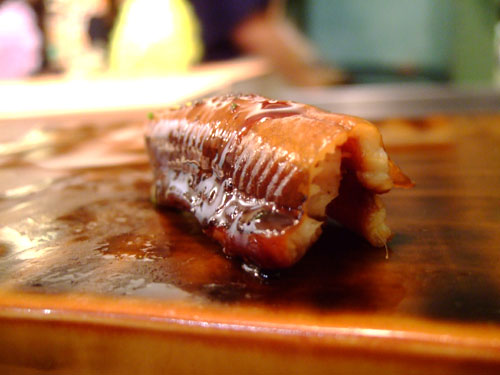
28. Anago - The eel's flesh was lean, soft, and broke apart easily in the mouth. The sauce added a bit of sweetness, but I was hoping for something fuller and richer. Perhaps unagi (freshwater eel) would better suit my taste here?
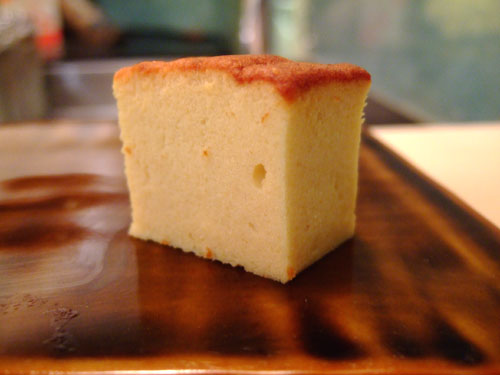
29. Tamago - Urasawa has one of the more interesting preparations of tamago I've seen. Instead of an omelet, you get something closely resembling a cake, and in fact, it's actually baked in a pan. The tamago first gives you a hint of egg flavor, then moves on to a long, subtly sweet finish. Quite nice, though my favorite tamago is still at Natori.
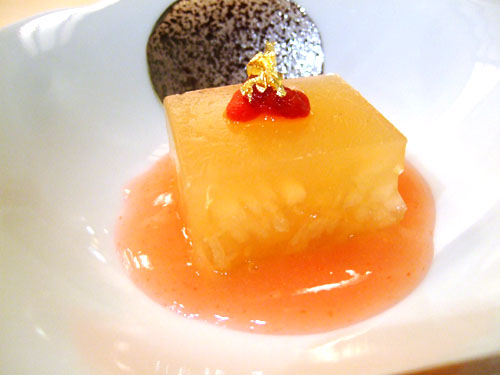
30. Nashi Gelée - A jelly-like concoction of nashi, or Asian, pear, with ume (Japanese apricot) sauce, goji berry, and gold flake. The gelée itself was very light and refreshing, and I especially enjoyed use of pieces of crisp pear in the dessert. The ume sauce was interesting in that it was more savory than sweet in flavor; thus, it wasn't particularly tasty when eaten alone, but provided a good foil to overt the sweetness of the pear.
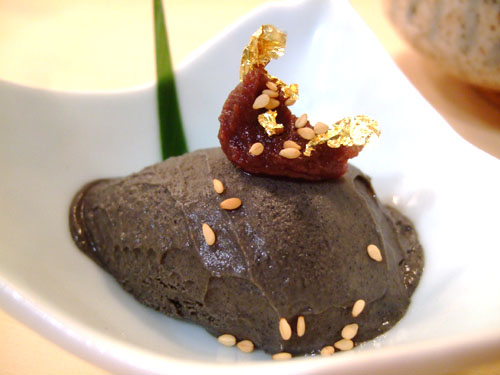
31. Goma Aisu Kurimu - On my previous visits, I've had white sesame ice cream, but this time it was black sesame ice cream, topped with sesame seeds, red bean paste, and gold flake. It was incredibly smooth, with an undeniably rich flavor, which I liken to the Chinese dessert tangyuan. I wanted to order a pint of this to take home!
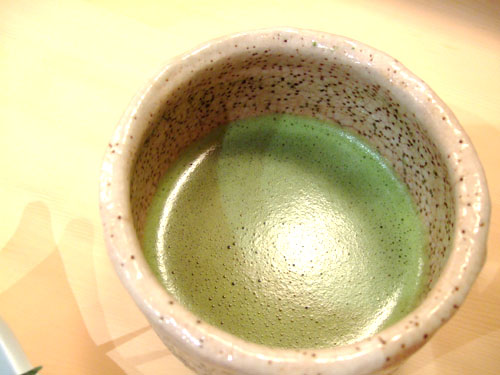
32. Matcha - Served here with dessert, matcha is a powdered green tea used in Japanese tea ceremonies. The taste was gritty, and slightly bitter, which contrasted nicely with the sweetness of the dessert. I noticed that, using a chasen, Urasawa-san whisks the tea on a special decorative mat, perhaps as a symbolic reference to Japanese tea ceremony?
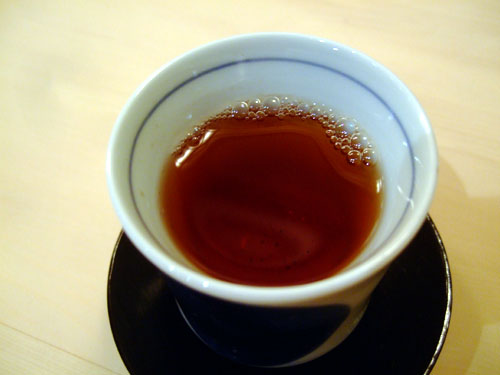
33. Hoji Cha - Hoji cha is a roasted green tea often drunk before one goes to sleep. It was quite delicious here, and I must've had four or five cups, as our servers kept giving us refills while we were chatting with Urasawa-san at the end of the meal.
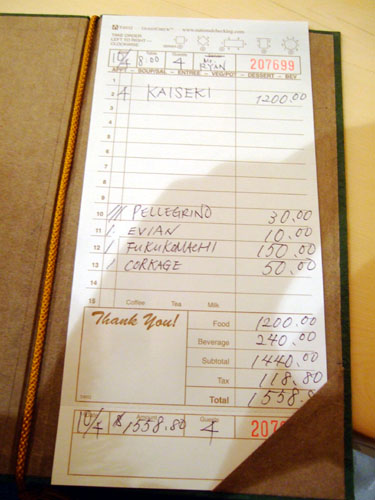
As expected, the bill was fairly prodigious, but totally worth it. I noted that the corkage fee had gone up from $30 to $50 since my last visit (it was $0 the first time I was here!).
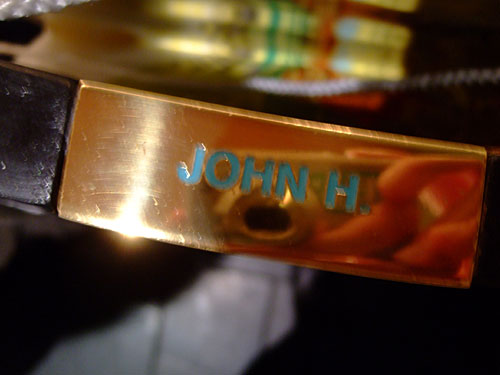
During my first visit to Urasawa, I'd wondered about the names on the chairs at the bar. I inquired this time, and it turns out that the chairs originate from the old Ginza Sushi-Ko (Masa Takayama's old restaurant). Money was tight, and in order to fund the restaurant, seats were sold to 20 "members" at $15,000 a pop. These members were entitled to 10% off their bill, and received preferential seating at the bar.
Once again, Urasawa delivers a simply epic meal, and reaffirms its spot at the top of the Japanese restaurant hierarchy. It's truly an experience unlike any other I've encountered in the States, a personal one where you get to really see the heart and soul of a chef. The only thing that marred my experience really had nothing to do with the restaurant: some of the other diners, including the one who nearly insulted Urasawa-san concerning his choice of uni. Such uncouth behavior (including drunken political diatribes about the $700 billion Fed bailout) really doesn't have its place here, and I could tell that Urasawa-san was a bit upset at this as well. I'm sure that, given the restaurant's increasing popularity, occurrences such as this are bound to increase in frequency. Perhaps in the future, we'd be wise to book up the entire restaurant as we did last time...
218 N Rodeo Dr, Beverly Hills, CA 90210
310.247.8939
www.yelp.com/biz/urasawa-beverly-hills (Yelp, restaurant has no web site)
Sat 10/04/2008, 08:00p-12:30a
Three times a charm? Since this is my third Urasawa report, I'll skip the typical introductory and decor sections (see my previous posts here and here for that) and get straight to the vittles. As an interesting aside, we found out that Urasawa-san's sister, Yoshie, was working here now. She started a while ago, after business picked up due to the restaurant's garnering of a two-star Michelin rating. Apparently, the secret's out!



A nice selection of premium sakes is available, and I always like to start with sake for the kaiseki portion of the meal, while I reserve Champagne for the sushi. Wine is also available, though I wonder about the reds. Wouldn't they overpower the delicate flavors of Urasawa's cuisine (especially the sushi)? The list is French- and California-focused, with mark ups being on the higher end of the range. Click for larger versions.


For sake, we went with a new one, the Fukukomachi [$150], a daiginjo (I believe the sake list incorrectly lists it as a junmai-daiginjo) from the Kimura Brewery in Akita. The details are: +5.0 specific gravity, 16.5% alcohol, 40% polish ratio, Yamadanishiki rice. I found it rather tasty: smoky, slightly viscous, with a tinge of fruity sweetness and vanilla. For the sushi, I brought a bottle of 2002 Louis Roederer Cristal Brut from my personal cellar (corkage is up to $50!). I liked it better than the last time I had it, at Capo. It seemed more refined, smoother, softer, yet still abound with hints of stone fruit, citrus, and toast; I think this will be even better with more age. We offered Urasawa-san some, and he seemed to enjoy it as well, finishing his entire glass!


1. Toro Tataki - Seared toro, orange ponzu, daikon, scallion, shiso, gold foil, chrysanthemum flower, shiso flower. The topping of scallion and daikon went wonderfully with the two beautifully seared pieces of toro, adding complexity and textural contrast, while the ponzu added a reverberating sweetness. A great way to kick off the meal, though I think the ponzu could've had more savory components (perhaps soy?) to offset its overt sweetness.


2. Hamo Nambanzuke - I think this was the first time I've had hamo. Hamo is also known as daggertooth pike conger eel, pike eel, or simply king eel (as Urasawa-san called it). Here, it was presented nambanzuke style, basically marinated in sweet vinegar and lightly fried, and covered by strands of carrot and grated sudachi. The eel had an initial sweetness and tartness (probably due to the marinade), which then led way to a ham-like smokiness. One of my dining companions even likened the taste to bacon!


3. Edamame Tofu - Edamame tofu is a type of kinugoshi (silken) tofu made from edamame, or fresh green soybeans (as opposed to soy milk), which give the tofu its unique pale green tint. It had a very soft, custard-like texture, with a flavor highlighted by nutty notes of soybean. In this dish, the tofu was accompanied by ikura, ebi, uni, mitsuba vegetable (Japanese wild parsley, or honeywort), and gold foil. The salmon roe added a great salty tang to the relatively mild tofu, while the mitsuba contributed a slight bitterness and a fantastic crunchiness to the dish.


In this most recent visit, it seemed like Urasawa-san's new assistant (and his brother-in-law), Ken I believe is his name, has been taking on more responsibility in terms of the food. Above, we see him preparing the sashimi course. As I mentioned in my last report, Urasawa-san's last assistant, Sung, has moved on to become a chef at French Laundry. Apparently, Sung wanted to learn more about French culinary technique, and, from what I understand, his desire became a reality when French Laundry's Chef de Cuisine Corey Lee came to visit Urasawa. Thomas Keller was a friend of Masayoshi "Masa" Takayama, Urasawa-san's teacher (legend has it Keller convinced Masa to move to New York), so it just seems appropriate that Urasawa-san and Keller's protégé, Lee, would cross paths.



4. Sashimi - Set in a hand-carved ice block, the three types of fish were toro from Boston, tai from Kyushu, and kampachi from Toyama. Accoutrements included fresh wasabi from Shizuoka (which produces over half of the wasabi in Japan), red cabbage, nori, and daikon. The toro was quite fatty, though a bit tendinous, while the snapper and kampachi were very mild and clean tasting, with no hint of fishiness. We were told to put seaweed in the provided soy sauce, which really complemented the fish, adding layers of complexity and contrast. A funny thing happened when I tried to sample the wasabi alone. Ken nearly jumped over the counter to stop me! I had to reassure him that I just wanted to see what the wasabi was like on its own.


5. Dobin Mushi - The dobin mushi was a soup consisting of matsutake mushroom, awabi, ebi, tai, gingko, mitsuba, and sudachi. The stock is dashi-based, which gives the soup a sweet-smoky taste, while the sudachi adds a notable tangy zest. The best part however, were the matsutakes and their woody, earthy flavor; the timing of our visit was good, as matsutake season starts in September. The soup was served in a clay tea pot, along with a small saucer. After eating the various ingredients, you pour the soup in the saucer to drink (tricky apparently--my dining companions had trouble with spillage), and the requisite small sips make you savor the soup even more. Fantastic!


6. Awabi "Karaage" - Fried Japanese abalone, served with a hint of sudachi juice. This was one of the best preparations of abalone I'd ever had, next to the awabi nigiri I had at Go's Mart. The pieces were tender, the result of six hours of boiling with kombu, but still had a delightful crunch. Taste-wise, the abalone was very subtle, very refined, great by itself, but enhanced even further by the zest of sudachi. I could just eat a whole bucket of this, like it were KFC popcorn chicken!




7. Seared Toro - I believe this was actually kama toro, or toro from the collar of the tuna. Rarer and pricier than mere toro, it's even more melt-in-your-mouth, and even more flavorful! Upon touching the hot stone, the fish produced a plume of rich, oily smoke that enveloped the surrounding area (that's why napkins were laid down--to protect the counter). Mouths watering, we waited intently as our servers lifted the toro off the hot stone and plopped it down into a bath of ponzu. At this point, the toro was looking not like fish, but beef. Eating the result was like an explosion of flavor and fat in my mouth, and elicited a moan of satisfaction from me.


8. Saga Beef - The meat was boiled with sake and soy for two days, resulting in an incredibly soft, yet rich consistency, and a taste that was both sweet and savory. Flavor-wise, it reminded me a bit of Chinese-style braised beef, but the texture was totally different. The fat was very fine, very integrated, but not overwhelming; it was easy to chew, but provided just enough resistance to make it interesting. The various vegetables, meanwhile, added some contrast to the meat; otherwise, it would've been too monolithic. I liked this even better than the Saga beef I had on my first visit to Urasawa.


Click the photo on the left for a video of Urasawa-san preparing a spiny lobster for our shabu-shabu course. He made sure to ham it up for the camera!








9. Shabu-Shabu - The number of ingredients for the shabu-shabu just keep on increasing. The first time, it was three, then four the next time, now five! We had ise ebi (spiny lobster), hotate (scallop), hamo (king eel), Saga beef, and foie gras. The first item our servers plopped in was the foie, followed by the lobster. The lobster came out quickly and was great, with a superb sweetness and snap. Next was the king eel, which I preferred to the nambanzuke version. The scallop came next, which I found to be a bit nondescript, the weakest of this quintet. Finally, it was time for the foie, which turned out wonderfully, with a subtle, yet powerful taste and a delightful, slightly rubbery texture; it was one of the best cooked preparations I've had (my best ever is still a foie gras terrine at French Laundry though). Following the foie was the beef, which was arguably my favorite of the bunch. Finally, we were instructed to take out and eat the kombu kelp (a change from previous visits, where the kombu stayed in).

10. Kombu Broth - As usual, the remaining kombu stock formed a hearty soup to enjoy before the sushi courses. This time, the soup had a very recognizable essence of foie gras, which had absolutely permeated the liquid! Upon sipping, you're hit initially by a light, kombu-tinged flavor, which quickly gives way to the richness of the foie.

With the appearance of gari (ginger), we knew that the gauntlet of sushi was about to begin.

11. Toro - Very nice, with a clean, yet rich taste, though noticeably less oily and less fatty than kama toro. Although Urasawa's toro is arugably the best I've had in the States, it wasn't quite as strong as the toro I had at Kyubey in Tokyo, which remains my best to date.

12. Seared Toro - The regular toro was just about perfect, but cooking the fish slightly seemed to make it even better. It softened the meat, accentuated the oiliness of the fish, and added a touch of smokiness that resulted in further complexity and contrast.

13. Kampachi - I preferred this preparation of kampachi to the sashimi version. It had a more toothsome taste as well as a more satisfying, crunchier texture.

14. Tai - A beautiful piece of fish, this snapper, as with the kampachi, outshone the sashimi we had earlier in the night. The sudachi zest added a fantastic tanginess to the fish, and the tai's slightly chewy texture was an added bonus.

15. Seki Aji - I was told that this was not mere aji (Spanish mackerel), but Seki aji from Kyushu. Considered pretty much the best aji available, Seki aji is caught in the Bungo Straight, which separates Kyushu from Shikoku; Seki saba is also available. The fish was very mild, lacking any of the offensive fishiness found in some lesser quality mackerels. I believe the only other place I've had Seki aji was Go's Mart. An interesting note: when we were served this, I asked about the distinction between aji and sawara. If I understood correctly, it seems like "sawara" refers to Spanish mackerel in the New York region, while outside the area, the term "aji" is generally used.

Click the photo above for a video of Urasawa-san preparing a piece of maguro nigiri sushi.

16. Maguro - We were told that this was bluefin tuna. Tuna can often times be quite boring, but the liberal use of wasabi here made the fish more interesting than I expected.

17. Shiitake - Urasawa remains the only place where I've had shiitake sushi. It's one that I look forward to, as its simple preparation really lets the woody, earthy nature of the mushrooms shine through, highlighted by a bit of wasabi.

18. Uni - This was some of the best uni I've had! Ridiculously creamy and quite sweet, it had absolutely no bitterness to it. The uni was from Santa Barbara. Unfortunately, one of the other diners at the restaurant, who I assume was drunk, rudely questioned this choice of SB uni, which seemed to upset Urasawa-san. He basically asked: "Why do you use Santa Barbara uni? Have you tried all the other unis? How do you know it's the best?" To which Urasawa-san replied: "Because I'm the chef!"

19. Ika - The toppings of sudachi and seaweed salt really added a fitting contrast to the mild flavor of the squid. Texture-wise, the ika was nicely firm, with a rich, almost creamy complexion that coated the mouth.

20. Mirugai - Mirugai is also known as geoduck. It had a refreshing crunch to it, as well as a clean, briny flavor and just a hint of sweetness.

21. Shima Aji - Striped jack or yellowjack, this was one of my favorites last time I was here. This time, it wasn't quite as strong, as it seemed to lack the level of complexity I experienced before. Nevertheless, it was still delectable.

22. Aji No Tataki - This was minced Spanish mackerel, along with shiro miso from Kyoto, scallion, shiso, and ginger. Urasawa is the only place I've seen do something like this. There were so many layers of flavor going on here, with the fish serving as a formidable base for the sweetness of the miso, bitterness of the scallion, and tang of the ginger and shiso.


23. Awabi - Here we see a before and after. The abalone had a nice firm crispness, with a good application of sudachi to counteract the brininess of the mollusk. Note the scoring on the surface of the abalone, which served to tenderize it.


24. Sanma - Mackerel pike or Pacific saury, with salt, sudachi, served on rice mixed with chopped shiso. The preparation of this dish was interesting, as it was made in one long piece of nigiri (I presume since the fish is long and thin), then cut, almost like a roll. It was "grilled" with a hot metal rod pressed against the top of the fish, which actually caused flames to shoot out from the surface! Again, I've never had anything quite like this at any other restaurant. The sanma had a distinctive saltiness and fishiness to it, balanced by a subtle sweetness.

Click on the photo above for a video of Ken preparing scallop. He cut open two scallops, only to find them unresponsive, and thus not fit for serving. They were thrown out, though I think we would've enjoyed eating them anyway!


So instead of scallop, we got spiny lobster instead. Click the photo on the left for a video of Ken prepping the live lobster, which continued to move about even after being cut in half!

25. Ise Ebi - Spiny lobster, otherwise known as rock lobster; despite the name, it's actually not a "true" lobster. Nevertheless, the flesh tasted very fresh (as it should, given the lobster was alive just minutes prior!), with a satisfying crunch and a nice bit of sweetness. I preferred this sushi preparation to the shabu-shabu above.


26. Negitoro Maki - Toro with negi (leek) and takuan (pickled daikon, believed to help aid digestion). The daikon came in a wheel-like shape, from which Urasawa-san cut long, thin strips. I really enjoyed the great crunch and sourness of the takuan and how the bitterness of the scallion contrasted with the richness of the tuna. It was good alone but even better when eaten with the provided soy sauce.

27. Gyusashi - This was our third helping of Saga beef! It had a mildly smoky flavor, paired with an extremely soft, yet chewy texture. I liked it better than shabu-shabu version. Delish!

28. Anago - The eel's flesh was lean, soft, and broke apart easily in the mouth. The sauce added a bit of sweetness, but I was hoping for something fuller and richer. Perhaps unagi (freshwater eel) would better suit my taste here?

29. Tamago - Urasawa has one of the more interesting preparations of tamago I've seen. Instead of an omelet, you get something closely resembling a cake, and in fact, it's actually baked in a pan. The tamago first gives you a hint of egg flavor, then moves on to a long, subtly sweet finish. Quite nice, though my favorite tamago is still at Natori.

30. Nashi Gelée - A jelly-like concoction of nashi, or Asian, pear, with ume (Japanese apricot) sauce, goji berry, and gold flake. The gelée itself was very light and refreshing, and I especially enjoyed use of pieces of crisp pear in the dessert. The ume sauce was interesting in that it was more savory than sweet in flavor; thus, it wasn't particularly tasty when eaten alone, but provided a good foil to overt the sweetness of the pear.

31. Goma Aisu Kurimu - On my previous visits, I've had white sesame ice cream, but this time it was black sesame ice cream, topped with sesame seeds, red bean paste, and gold flake. It was incredibly smooth, with an undeniably rich flavor, which I liken to the Chinese dessert tangyuan. I wanted to order a pint of this to take home!

32. Matcha - Served here with dessert, matcha is a powdered green tea used in Japanese tea ceremonies. The taste was gritty, and slightly bitter, which contrasted nicely with the sweetness of the dessert. I noticed that, using a chasen, Urasawa-san whisks the tea on a special decorative mat, perhaps as a symbolic reference to Japanese tea ceremony?

33. Hoji Cha - Hoji cha is a roasted green tea often drunk before one goes to sleep. It was quite delicious here, and I must've had four or five cups, as our servers kept giving us refills while we were chatting with Urasawa-san at the end of the meal.

As expected, the bill was fairly prodigious, but totally worth it. I noted that the corkage fee had gone up from $30 to $50 since my last visit (it was $0 the first time I was here!).

During my first visit to Urasawa, I'd wondered about the names on the chairs at the bar. I inquired this time, and it turns out that the chairs originate from the old Ginza Sushi-Ko (Masa Takayama's old restaurant). Money was tight, and in order to fund the restaurant, seats were sold to 20 "members" at $15,000 a pop. These members were entitled to 10% off their bill, and received preferential seating at the bar.
Once again, Urasawa delivers a simply epic meal, and reaffirms its spot at the top of the Japanese restaurant hierarchy. It's truly an experience unlike any other I've encountered in the States, a personal one where you get to really see the heart and soul of a chef. The only thing that marred my experience really had nothing to do with the restaurant: some of the other diners, including the one who nearly insulted Urasawa-san concerning his choice of uni. Such uncouth behavior (including drunken political diatribes about the $700 billion Fed bailout) really doesn't have its place here, and I could tell that Urasawa-san was a bit upset at this as well. I'm sure that, given the restaurant's increasing popularity, occurrences such as this are bound to increase in frequency. Perhaps in the future, we'd be wise to book up the entire restaurant as we did last time...
25 Comments:
Yesterday was my chinese homework day. Today is my blogging and real work day so hopefully I'll finish today :P
A part of me is embarassed to start blogging now that I have read yours it's so good, detailed, articulate. Photos are sharp and presented professionally AND you even have videos again!!!
Aaargghhh should have finished mine before reading yours!!! Heheheh I need to go google crazy today as there were lots of background I didn't know as well...
zomg. *dies*
What you know about Japanese food makes what I know about Japanese food seem like child's play. I have so much to learn. We need to eat Japanese together sometime, although I have no idea when Urasawa is going to be in my budget. Some wise Chouhounder suggested I start an "Urasawa fund". Maybe I will start today by putting $40 under my mattress.
The photos and descriptions are so wonderful, I am just pining over here!
Hey Kevin,
Burgundy is a GREAT match to sushi, the acidity and the subtle waves of fruit and flavor work really well. It's a wine that doesn't overpower any of the ingredients of sushi and it cuts through the fat of the sushi well enough as well. Burgundy goes well with everything of course hehe.
GOod to see the 02 cristal was tasty, the 2000 was really disappointing (for the price).
Oh also, does it cost more for 2nds/3rds of a sushi item?
Hey Kevin, I've been keeping up with your blog, and I wanted to tell you that this was my favorite post of yours to date. It was clear, to the point, and had some fantastic pictures. Keep posting!
Hey Kevin,
How do I blur out people's faces??? You seem to do that and that's a cool feature. Also it means that friends won't be offended at pictures I post :P
Thanks heaps
Tubs!!!
tubs: Hopefully I've given you some inspiration! And I think I have a lot of the necessary info in my post already, so I don't think you'll need to do too much more research. ;) As for the blurring of people's faces, I use Photostop, so you can just email the pic and I'll do it for you. I opted not to post the group pic this time since I wasn't sure you'd like that. In any case, just get your review up soon! =)
food, she though.:I'll admit that I didn't know everything in this post before I started. There was some research involved. ;) We should do a meal sometime, though certainly it doesn't have to be Urasawa! You wouldn't be the first person I've heard of starting an "Urasawa fund" though. ;)
charlie fu: We've never been charged more for second helpings, but I imagine the price might go up if you ask for a lot more. ;) Regarding the 2000 Cristal, I'm surprised you didn't care for it. We had it on our last trip to Urasawa and quite liked it! Thanks for the tip about Burgundy. I've never attempted to pair a red with sushi, but perhaps this gives me an excuse to bring out the DRC...
andrew froug: Thanks Andrew! This was one of my favorite posts as well. Urasawa tends to bring out the best. ;)
great review as always. how long is a typical meal at urasawa? does service start at the same time or do people trickle in during the night?
For us, a meal is usually 4-5 hours. Service can start at staggered times, though your seat is yours for the entire night. ;)
hey kevin!
i finally got to try urasawa! i loved it..except it was waaaay too much food =)
does hiro ever make fun of you for taking pictures? =P
- grace
Waaaay too much food? I thought it wasn't quite enough heh. ;)
As for the photos, Hiro has said "$5 per picture" before!
really? the lady next to us stopped eating after ONE piece of sushi...very very weak...
i used to do a lot of tasting menus..but i feel like i'm going to burst everytime..so i must give my stomach a rest! =)
anyways i enjoyed your review!
- grace
One piece eh? I wonder if she had to pay the full $300 tab!
SIGH...is it possible to fall in love with a man i've never met? i'm speaking of Chef Urasawa of course! he seems like such a classy, dignified, and humble man. i LOVED how you added videos in your third installment. it really gives life to the way you've been describing Urawasa all along. AWESOME review, Kevin! incase i didn't tell you the first few times, your blog is one of my most viewed bookmarks. i can't wait to get my Urawasa fund going so I can experience the goodness myself. Thanks!! Jane (j44lee.yelp.com)
Jane, yes I do believe it's possible to fall in love that way! Hiro is all that you've said, if not more. The videos do go quite a ways in demonstrating to the reader the unique culinary adventure that is Urasawa; I wish I would've taken more!
Do experience it for yourself though. The place is definitely worth saving up for, and you wouldn't be the first person I've heard of to start an Urasawa fund.
BTW, my Yelp page was formerly kevineats.yelp.com, but I recently got banned from the site after posting links to my blog. "Spammy" and "irrelevant" they said...I'm still deciding if I want join back again.
Yes, I see what you mean. This looks wonderful. I'll have to schedule a visit to LA :)
Yep, this is a must-visit if you're in LA. A lot of people say Urasawa's the best Japanese restaurant in the country, and I can believe it. The only place that I could imagine being better is Masa in NY.
All three of your Urasawa posts have been NSFW. That was complete and utter food porn.
Haha thanks. Never thought of myself as a pornographer before. ;)
kevin, wanted to say thanks. we went last saturday night, in large part because i came across your blog from chowhound(we are not from la) thanks for the introduction. it was life changing,cant wait to go back,
henry
Thanks Henry! I'm glad you were able to experience Urasawa; it is truly a meal unlike any other.
Ken used to work for Nano at a Sushi restaurant in Torrance. This place was really great until the chef retired.
What was the name of the place? Also, why did Ken leave? Was it just because the chef retired?
Hi kevin! This post is really wonderful :)
I just want to ask a question, I really want to go to this place, but I'm not sure about the price today. I wonder if you still go back to the restaurant and is the price for the meal still 300 pp? or does it went to 500pp?
Thank you! :D
Sally, I believe it's now $375pp, which is easily $500pp out the door!
Post a Comment
Subscribe to Post Comments [Atom]
<< Home